 Cherub - the Vampire with Bunny Slippers has reached the end of its season 2 run and that will be the final Cherub episode. All episodes from season 1 and 2 are still available for download in a variety of formats and Caution Zero intend to release the whole kit and caboodle on DVD - details at the site.
Cherub - the Vampire with Bunny Slippers has reached the end of its season 2 run and that will be the final Cherub episode. All episodes from season 1 and 2 are still available for download in a variety of formats and Caution Zero intend to release the whole kit and caboodle on DVD - details at the site.
Saturday, September 30, 2006
Cherub - end of an era
Posted by
Taliesin_ttlg
at
2:32 AM
4
comments
![]()
DVD Release: Ganja & Hess
 Another rare old film released in time for Halloween. Reported over at newsday.com. They report the synopsis as:
Another rare old film released in time for Halloween. Reported over at newsday.com. They report the synopsis as:
"The late Duane Jones - whose immortality in horror movie history is sealed for playing the sane, stalwart hero of the 1968 classic "Night of the Living Dead" - stars as Dr. Hess Green, a wealthy African-American archaeologist who takes on an assistant (Nunn) who's apparently suicidal and homicidal.
One night, the assistant stabs Hess in the chest with one of the latter's recent finds: an ancient dagger, which, it turns out, is contaminated with a virus that gives its victims immortality and blood lust. The good doctor finds immediate gratification when the assistant butchers himself in Hess' bathroom. This, of course, is nowhere near enough to sate his thirst. At first, he burglarizes local blood banks. Then he goes after live victims, most of them poor minorities living far from Hess' lavish upstate New York digs.
Soon, Ganja (Marlene Clark), the haughty, arresting wife of Hess' dead assistant, arrives unannounced on the doctor's doorstep looking for her "crazy" husband. Hess insists the assistant is long gone, but she camps out at the manse, abusing the help and seducing the master. Hess, in love and in need of someone with whom to share the hunger, infects Ganja. Reader, they marry - and then look for more victims. Ganja, it turns out, doesn't have the heart for the chase, which seems a little surprising, since she showed no prior evidence of having any heart whatsoever."
The film had, back in the day, been recut as a blaxploitation. However, the original is meant to be a film of savage imagery and from 10th October we can all find out. A region 1 release.
Posted by
Taliesin_ttlg
at
12:26 AM
0
comments
![]()
Friday, September 29, 2006
Vampire Beach Babes
 Well the name says it all! The Vampire Beach Babes are a goth/surf band. Over at their homepage you can have a listen to some of their material. Their latest music has taken on a definitively darker edge.
Well the name says it all! The Vampire Beach Babes are a goth/surf band. Over at their homepage you can have a listen to some of their material. Their latest music has taken on a definitively darker edge.
The exiting part is that VBB are playing in Blackpool next month (on the 26th October), as a warm-up to their Whitby Goth Weekend appearance, at the Misery of Sound. Tickets are £3.00, and are available via Odddd-boots, or you can pay £4.00 on the door.
The band will be supported by horrorpunk band Pink Hearse.
Posted by
Taliesin_ttlg
at
8:38 AM
0
comments
![]()
New Film: Exit 38
 PR Web have reported that Star Energy Productions have announced the completion of vampire movie "Exit 38". Having glanced at the trailer it looks a little low budget but, as with all vampire films, when the opportunity arrises I'll give it a fair go.
PR Web have reported that Star Energy Productions have announced the completion of vampire movie "Exit 38". Having glanced at the trailer it looks a little low budget but, as with all vampire films, when the opportunity arrises I'll give it a fair go.
The company's next film is to be "Midnight" a vampire western.
Posted by
Taliesin_ttlg
at
12:08 AM
0
comments
![]()
Thursday, September 28, 2006
Music: Black Magic Reggae
 Regular poster Crabstix has given me a CD called “Black Magic Reggae”, primarily because of some of the tracks on disc 2 that have vampiric themes. He also suggested I review said disc. Unfortunately I have only highlighted music, never reviewed it (except in respect to the soundtrack of Nosferatu 1922) and I don’t think I could do the disc justice as reggae isn’t really my cup of tea.
Regular poster Crabstix has given me a CD called “Black Magic Reggae”, primarily because of some of the tracks on disc 2 that have vampiric themes. He also suggested I review said disc. Unfortunately I have only highlighted music, never reviewed it (except in respect to the soundtrack of Nosferatu 1922) and I don’t think I could do the disc justice as reggae isn’t really my cup of tea.
However, for those who like reggae and want some vampiric themed tracks, disc 2 offers the following:
The Vampire by The Upsetters
Dracula Prince of Darkness by King Horror
Dracula by The Vulcans
Dracula by Desmond Dekker
Return of the Vampire by The Upsetters
Ketch Vampire by Devon Irons and Doctor Alimanado
Vampire Dub (aka Vamp a Dub) by the Upsetters
Blacula by The Crystalites
As well as 31 other horror themed reggae songs.
Posted by
Taliesin_ttlg
at
8:46 AM
1 comments
![]()
Wednesday, September 27, 2006
The Night Flier - review
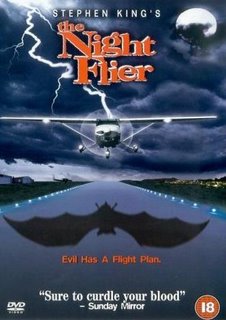 Director: Mark Pavia
Director: Mark Pavia
Release Date: 1997
Contains spoilers
My first reaction to this film was, unfortunately, bound to be negative. Firstly it is a Stephen King adaptation and, with notable exceptions such as Salem’s Lot (1979 and 2004), The Shinning and Carrie his horror story adaptations are often fairly poor. Secondly because the concept of a Cessna flying vampire seems, on the surface at least, ridiculous.
However, the film does actually work and it is a prime example of a vampire movie that, as well as proving fairly gory, actually has something to say about the world.
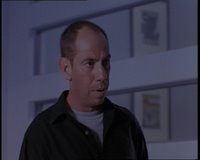 Richard Dees (Miguel Ferrer) is a tabloid journalist of the lowest common denominator of tabloids. The Inside View is the sort of tabloid that comes up with frontpage headlines such as “Man Captured by Flying Saucer”, peddling the worse sort of “news” and Dees is the top reporter. He is given the assignment of looking for a man who flies into small airports in his Cessna and murders someone, draining them of blood. The editor, Merton Morrison (Dan Monahan), is exited by the story especially as the man goes by the name Dwight Renfield (Michael H. Moss).
Richard Dees (Miguel Ferrer) is a tabloid journalist of the lowest common denominator of tabloids. The Inside View is the sort of tabloid that comes up with frontpage headlines such as “Man Captured by Flying Saucer”, peddling the worse sort of “news” and Dees is the top reporter. He is given the assignment of looking for a man who flies into small airports in his Cessna and murders someone, draining them of blood. The editor, Merton Morrison (Dan Monahan), is exited by the story especially as the man goes by the name Dwight Renfield (Michael H. Moss).
Morrison makes no secret of knowing where the name Dwight Renfield has come from. It is an amalgam of Dwight Frye, the actor, and his character Renfield whom he played in the 1931 version of Dracula. Dees does not want the story, however, the type of plane and tail number is known to the Federal Aviation Administration (FAA) and he is bound to be caught soon. He suggests that the story be given to wet behind the ears reporter Katherine Blair (Julie Entwistle), whom he nicknames Jimmy (after Olsen, from Superman).
Dees is an unpleasant character, arrogant and full of self-importance, but when Jimmy asks him for advice he offers two pieces. Firstly he tells her that the stories have a way of getting inside your head, which is what happened to her predecessor – who then killed herself. He also advises to, “Never believe what you publish, and never publish what you believe.” Both pieces of advice should have been remembered by himself.
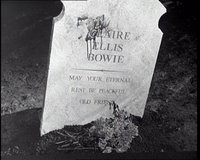 When Renfield strikes again we see just how reprehensible Dees is. He takes the story back and follows the murder trail. With the first victim, Claire Bowie (Richard K Olsen), he goes to the grave, replaces flowers with dead flowers, kicks the gravestone crooked and wipes blood on it to get a decent shot. It is during this visit that strange things start happening to Dees as Renfield starts warning him off.
When Renfield strikes again we see just how reprehensible Dees is. He takes the story back and follows the murder trail. With the first victim, Claire Bowie (Richard K Olsen), he goes to the grave, replaces flowers with dead flowers, kicks the gravestone crooked and wipes blood on it to get a decent shot. It is during this visit that strange things start happening to Dees as Renfield starts warning him off.
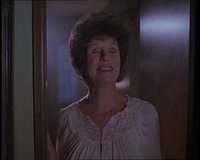 As he follows the trail we learn much about the vampire. His victims often seem enamoured by him, actually becoming dreamy and welcoming, though in his cape he looks odd. Most have the FAA warning about his plane and yet do not report his presence. The bite wounds are not the small bites of your standard vampire. Bowie’s throat is completely ripped out. Other victims have huge punctures either side of their necks as though railroad spikes have been thrust into their necks.
As he follows the trail we learn much about the vampire. His victims often seem enamoured by him, actually becoming dreamy and welcoming, though in his cape he looks odd. Most have the FAA warning about his plane and yet do not report his presence. The bite wounds are not the small bites of your standard vampire. Bowie’s throat is completely ripped out. Other victims have huge punctures either side of their necks as though railroad spikes have been thrust into their necks.
Mirrors near the victims are smashed, we later discover that they break as the creature passes and also later discover that the vampire casts no reflection in intact mirrors – cleverly shown as we see a stream of blood flow into a urinal but see no vampire, how often do we get a vampire relieving himself in a movie? There is a hint that the vampire can control dogs, as Dees confronts a particularly vicious beast that chases him and yet is back in its starting position when he gets to his car. The vampire’s plane often has fetid, maggot and worm infested soil beneath it and this later is seen to be his bed within the plane. As he only flies at night and the plane’s windows are curtained we can assume an aversion to sunlight.
Yet it is also interesting that Dees himself is a vampire (of sorts). When he comes across a car crash he takes photos, actually shifting the bodies to get a more sensational shot, and refers to it as a bonus. He tricks Jimmy, who is put back on the story by an annoyed and devious Morrison, into helping him and then locks her in a wardrobe. He uses people, the living and the dead, to get his story. This is why the vampire warns him off, he is as fascinated with Dees as Dees is with him. In fact Dees finds copies of the Inside View inside the vampire’s plane. The vampire sums it up when he admits that Dees' “appetite for blood intrigues me.”
 We do not see the vampire clearly at first, just shadowy views of a high necked cape. Then we get three images. The first is in old photographs which are, presumably, of the vampire when mortal. These are old black and white shots of a man and woman and the man is obviously an early pilot. At the end of the film we do see him with a human face.
We do not see the vampire clearly at first, just shadowy views of a high necked cape. Then we get three images. The first is in old photographs which are, presumably, of the vampire when mortal. These are old black and white shots of a man and woman and the man is obviously an early pilot. At the end of the film we do see him with a human face.
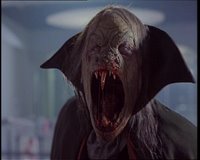 More fascinating, however, is the view of the vampire when he is on the rampage. With talon claws and his great monster like head, complete with huge retractable front placed fangs, this is one of the most monstrous views of a vampire you are likely to see in a movie.
More fascinating, however, is the view of the vampire when he is on the rampage. With talon claws and his great monster like head, complete with huge retractable front placed fangs, this is one of the most monstrous views of a vampire you are likely to see in a movie.
The film spins on to a nicely twisted ending.
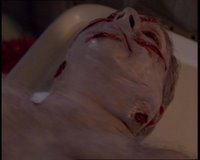 The film has its problems, there are unanswered plot pieces and the overall concept takes a huge suspension of disbelief to buy. However it has several selling points. Firstly the character of Dees, skilfully portrayed by Ferrer is so utterly unlikeable and yet we are carried with him. This character, this hunter, is probably worse than the vampire. The vampire might rampage through victims, though it is clear that at least one is at peace with her fate, but Dees actively preys on the dignity of the living and dead and has no moral compunction. This allows the film to damningly indict such sensationalist journalism, which is another great selling point. The fact that the vampire is so monstrously portrayed is also great.
The film has its problems, there are unanswered plot pieces and the overall concept takes a huge suspension of disbelief to buy. However it has several selling points. Firstly the character of Dees, skilfully portrayed by Ferrer is so utterly unlikeable and yet we are carried with him. This character, this hunter, is probably worse than the vampire. The vampire might rampage through victims, though it is clear that at least one is at peace with her fate, but Dees actively preys on the dignity of the living and dead and has no moral compunction. This allows the film to damningly indict such sensationalist journalism, which is another great selling point. The fact that the vampire is so monstrously portrayed is also great.
With nice referential points this film deserves no less than 6.5 out of 10.
The imdb page is here.
Posted by
Taliesin_ttlg
at
1:53 PM
2
comments
![]()
Tuesday, September 26, 2006
Anita Blake - the comic
 Nip on over to Comic Book Resources to view the eight page preview of Marvel's new Anita Blake comic. This seems set around the Guilty Pleasures book and there is plenty of material to make this a great comic book run - before the novel series became, perhaps, too adult to be a mainstream comic.
Nip on over to Comic Book Resources to view the eight page preview of Marvel's new Anita Blake comic. This seems set around the Guilty Pleasures book and there is plenty of material to make this a great comic book run - before the novel series became, perhaps, too adult to be a mainstream comic.
Posted by
Taliesin_ttlg
at
9:24 PM
0
comments
![]()
I Am Legend – news – bad, good, worse
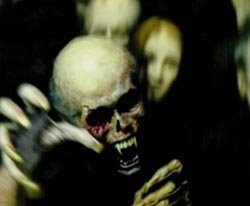 Further news on I Am Legend from IESB.net.
Further news on I Am Legend from IESB.net.
Bad news: Johnny Depp will not be in the movie.
Good News: The character Philip, a second survivor whom it was believed Depp would play, is not in the script. A character addition that was sure to wreck the movie.
Worse News: The film will be closer to the Omega Man than the Novel. Okay, that’s not so much worse news as devastating news.
Posted by
Taliesin_ttlg
at
7:43 AM
0
comments
![]()
Monday, September 25, 2006
Thirst {1979} – review
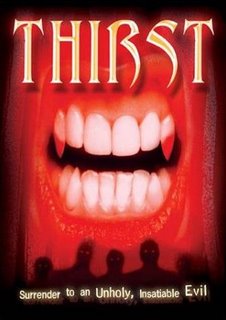 Directed By: Rod Hardy
Directed By: Rod Hardy
Release Date: 1979
Contains spoilers
It was purely coincidental that I had decided to review this Australian film at the same time that I discovered there was to be not one but two new vampire films, both called “The Thirst”, released. The DVD had been hovering around on my ‘really should get it out and review it’ list for some time.
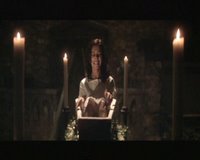 The film begins with a woman, we later discover to be Kate Davis (Chantal Contouri), waking in a coffin and screaming; there are tears on her cheeks. She makes her way through the walled up crypt to a stream of light. We hear voices discussing her, she is responding says one, is it safe asks another. We hear that it is a standard conditioning procedure. It is not your standard opening to a vampire movie, sure we have the waking in a coffin but most newly risen vampires don’t scream and what is this about conditioning? Then again, Thirst is anything but standard.
The film begins with a woman, we later discover to be Kate Davis (Chantal Contouri), waking in a coffin and screaming; there are tears on her cheeks. She makes her way through the walled up crypt to a stream of light. We hear voices discussing her, she is responding says one, is it safe asks another. We hear that it is a standard conditioning procedure. It is not your standard opening to a vampire movie, sure we have the waking in a coffin but most newly risen vampires don’t scream and what is this about conditioning? Then again, Thirst is anything but standard.
The film cuts back a week and Kate is at home with her housekeeper Lori (Rosie Stugess) and she is getting ready for a holiday. Her boyfriend, Derek (Rod Mullinar) – a man with a bad porn film moustache, visits her but they are unaware that they are observed. She is then discussed in some form of board room. One of the people, Mr Hodge (Max Phipps), is excited about his and her family being reunited. Dr Fraser (David Hemmings) warns that it will only be by her consent.
The next day Kate picks up some milk and then speaks on the phone to Derek. As she does so the cat, back in the kitchen, knocks over the milk carton. The carton contains blood. She tries to make a phone call and the line emits a high pitched tone and figures burst in. Kate comes round just after she is transferred from a plane to a car. She is taken to a facility run by the Hyma society. They talk to her about her ancestry and one of the society, Mrs Barton (Shirley Cameron), tells her that she is a descendant of Countess Báthory. The picture she is shown has Báthory with fangs. Now this is out with the historical Báthory, of course, but fits in well with the film as we shall see.
The Hyma society dislike the word vampire, they see themselves as a superior race that have discovered that the drinking of blood provides youth and power. 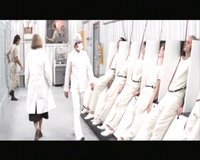 The facility itself is a farm; inmates (called alternatively donors or blood cows) are kept on the farm, prisoners who are given tranquilisers to keep them docile. There is a festival of some of the 70,000 vampires worldwide to take place there and, when the visitors are given a tour of the facility, we discover that the farms were created as an answer to blood impurities. Certain blood diseases are mentioned, and they also mention that penicillin could lead the vampire to suffer from anaphylactic shock. This is not expanded upon, and one wonders whether the intolerance to penicillin is part of their vampiric condition or not? The blood is packaged in milk cartons for delivery to society members.
The facility itself is a farm; inmates (called alternatively donors or blood cows) are kept on the farm, prisoners who are given tranquilisers to keep them docile. There is a festival of some of the 70,000 vampires worldwide to take place there and, when the visitors are given a tour of the facility, we discover that the farms were created as an answer to blood impurities. Certain blood diseases are mentioned, and they also mention that penicillin could lead the vampire to suffer from anaphylactic shock. This is not expanded upon, and one wonders whether the intolerance to penicillin is part of their vampiric condition or not? The blood is packaged in milk cartons for delivery to society members.
 We also discover that the highest honour for a donor, though I doubt many of them would see it, is to be completely exsanguinated. Though it is not mentioned, one assumes that the society believes the second highest honour to be that of taking part in a ritual.
We also discover that the highest honour for a donor, though I doubt many of them would see it, is to be completely exsanguinated. Though it is not mentioned, one assumes that the society believes the second highest honour to be that of taking part in a ritual.
We do get to see the society celebrate its rituals. This was interesting as they seem to mix the very modernistic view of vampires that the film creates, which tie in heavily with Báthory the serial killer, with more traditional vampire myth imagery. The vampire puts in silvered false fangs; hence the picture shown of Báthory might have been wearing such fangs rather than sprouting them (super)naturally. Then we see the eyes flash red as they approach the victim. It was this eyes flashing red that was anachronistic and more traditional in nature. It might have been part of Kate’s conditioning to see this but we also see her eyes flash red at one point. Perhaps there is something more supernatural going on? This is underlined when the cat knocks over the carton of blood at the beginning of the film, Kate gets blood on her finger and, almost subconsciously, licks the blood from her finger – the cat hisses at her and this leaves a feeling that there is a supernatural element also. It should also be noted, as per the ritual screenshot above, that the belief that vampirism offered youth seems to have been optimistic to say the least.
It was this eyes flashing red that was anachronistic and more traditional in nature. It might have been part of Kate’s conditioning to see this but we also see her eyes flash red at one point. Perhaps there is something more supernatural going on? This is underlined when the cat knocks over the carton of blood at the beginning of the film, Kate gets blood on her finger and, almost subconsciously, licks the blood from her finger – the cat hisses at her and this leaves a feeling that there is a supernatural element also. It should also be noted, as per the ritual screenshot above, that the belief that vampirism offered youth seems to have been optimistic to say the least.
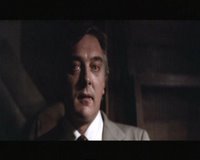 The majority of the film surrounds Kate’s conditioning, with almost a bad cop, Mrs Barton, and a good cop, Dr Fraser, scenario going on. The conditioning itself is psychotropic in nature, with Kate forced into almost familiar surroundings that become twisted and nightmarish. This is both the strength and weakness of the film. Strength because, other than one really bad effect that I’ll mention later, it is really well done, weakness because that is about the top and bottom of the story, there seems to be little other meat to it. The concept of the Hyma society was brilliant and I would have liked to have seen more about them and their ways.
The majority of the film surrounds Kate’s conditioning, with almost a bad cop, Mrs Barton, and a good cop, Dr Fraser, scenario going on. The conditioning itself is psychotropic in nature, with Kate forced into almost familiar surroundings that become twisted and nightmarish. This is both the strength and weakness of the film. Strength because, other than one really bad effect that I’ll mention later, it is really well done, weakness because that is about the top and bottom of the story, there seems to be little other meat to it. The concept of the Hyma society was brilliant and I would have liked to have seen more about them and their ways.
The acting is passable, though I was not convinced by Contouri’s performance as Kate, okay she was on the verge of insanity but it did seem a little too whiney. This woman was, allegedly, a successful business woman. I would have expected a little more get up and go (literally). There was one scene where she slapped Mrs Barton but, generally, she was only ever portrayed as the victim.
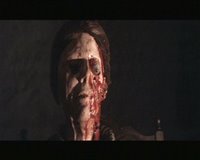 The poor effect I mentioned earlier is pictured - the rotting face of Kate’s housekeeper. An unfortunate effect as it looked so very false. The rest of the effects were well done, though admittedly most centred around blood. The soundtrack was, unfortunately, very cheesy.
The poor effect I mentioned earlier is pictured - the rotting face of Kate’s housekeeper. An unfortunate effect as it looked so very false. The rest of the effects were well done, though admittedly most centred around blood. The soundtrack was, unfortunately, very cheesy.
This is a film that will annoy the traditional vampire fan but I was taken by its unusual approach to the subject matter. Certainly the concept of actually farming humans has been used since but this did it in such a classy way, which almost felt as though the spirit of The Prisoner had been captured when it came to the drugged and docile donors. 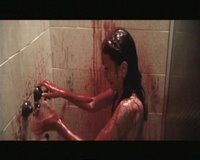 Despite some of the gripes I have mentioned this is certainly one that I would recommend genre fans looking at and also anyone interested in seeing a film that chronicles a psychological dismemberment of the victim – I realise I have mentioned little about the conditioning but as it is the main thrust of the film I wanted to leave it fairly sacrosanct.
Despite some of the gripes I have mentioned this is certainly one that I would recommend genre fans looking at and also anyone interested in seeing a film that chronicles a psychological dismemberment of the victim – I realise I have mentioned little about the conditioning but as it is the main thrust of the film I wanted to leave it fairly sacrosanct.
A strong 6.5 out of 10 for the originality shown.
The imdb page is here.
Posted by
Taliesin_ttlg
at
7:08 AM
0
comments
![]()
Labels: Erzsébet Báthory, pureblood, vampire
New Film: Dracula’s Curse
 Not a lot of detail on this but seems to be an elite hunter squad type film. There is a MySpace page with a couple of trailers and, for a straight to DVD, it does look fairly slick. That said… I do get picky when a film adds the name Bram Stoker to the title and, although in this case there is already a film called (in the US) Dracula’s Curse, let’s hope they can live up to placing the great man’s name in the title.
Not a lot of detail on this but seems to be an elite hunter squad type film. There is a MySpace page with a couple of trailers and, for a straight to DVD, it does look fairly slick. That said… I do get picky when a film adds the name Bram Stoker to the title and, although in this case there is already a film called (in the US) Dracula’s Curse, let’s hope they can live up to placing the great man’s name in the title.
Posted by
Taliesin_ttlg
at
4:41 AM
0
comments
![]()
Sunday, September 24, 2006
New Film: The Thirst
 Just to confuse us all, I mentioned a new film starring Claire Kramer called The Thirst some time ago. Well there is another film called the Thirst being produced at the same time – this one with Jason Connery and Tony Todd in it. The pictures is of America Olivio in her role as Amelia.
Just to confuse us all, I mentioned a new film starring Claire Kramer called The Thirst some time ago. Well there is another film called the Thirst being produced at the same time – this one with Jason Connery and Tony Todd in it. The pictures is of America Olivio in her role as Amelia.
A homepage with trailer can be found here.
To further confuse things watch out for the review of the 1979 Australian film Thirst soon.
Posted by
Taliesin_ttlg
at
10:18 AM
0
comments
![]()
The House that Dripped Blood – review
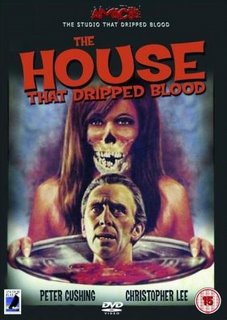 Released: 1971
Released: 1971
Director: Peter Duffell
Contains spoilers
The House that Dripped Blood is another Amicus film made up of short horror stories, this time written by Robert Bloch. The vampire segment (The Cloak) is the final section, although it is also part of the story that binds the parts together.
Detective Inspector Holloway (John Bennett) has been called into the unnamed town, from Scotland Yard, to investigate the disappearance of an actor, Paul Henderson (Jon Pertwee). The local copper, Sergeant Martin (John Malcolm), informs him that it is not the first strange event that has occurred to a resident of the house Henderson had rented and, through Martin, we hear the first two tales.
The first is entitled “Method for Murder” and sees a writer, Charles Hillyer (Denholm Elliott) being stalked by his own character. The second, “Waxwork”, sees retired business man Phillip Grayson (Peter Cushing) becoming obsessed with a wax dummy of Salome in a horror waxwork display. Interestingly one of the wax works is of Dracula and looks very much modelled upon Christopher Lee.
Holloway then goes to the estate agent, A J Stoker (John Bryans) – a reference undoubtedly to Bram Stoker – who continues with the tales. We hear the story of John Reid (Christopher Lee) in a segment entitled “Sweets to the sweet”, a story of witchcraft that is the best segment of the film. Finally we get to the vampire story, a segment played very much as a comedy – where the other segments were of a very sombre timbre.
Stoker rents the house to Henderson, a horror actor who is making a film entitled “Curse of the Bloodsuckers”, co-staring Carla Lynde (Ingrid Pitt). Henderson is not happy about the production. The sets are fake and wobbly, the director inexperienced and the costumes aren’t right. There is a wonderful line when Henderson laments the demise of the classic horror movie and mentions Dracula, “The one with Bela Lugosi, of course… Not this new fellow.” An obvious reference to Christopher Lee, who was in the earlier segment, and produced by Amicus’ rivals Hammer Horror.
Henderson has rejected the cloak he has been given and declares that he will find his own. 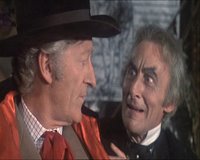 In his dressing room he finds a card for a costumers shop, though no-one admits leaving it. He goes to the costumers, a cobweb festooned shop with much occult paraphernalia, and meets the owner Von Hartmann (Geoffrey Bayldon). Von Hartmann shows him a vampire cloak and, rather than offer it for rent, offers it for a very cheap sale. When Henderson leaves the shop Von Hartmann says that now, finally, he can rest.
In his dressing room he finds a card for a costumers shop, though no-one admits leaving it. He goes to the costumers, a cobweb festooned shop with much occult paraphernalia, and meets the owner Von Hartmann (Geoffrey Bayldon). Von Hartmann shows him a vampire cloak and, rather than offer it for rent, offers it for a very cheap sale. When Henderson leaves the shop Von Hartmann says that now, finally, he can rest.
Back at the studio, the next day, Henderson is getting ready. He puts the cloak on and, to his shock, discovers that his reflection has vanished. When he removes the cloak it reappears but he is called to set before he can fully take in what it means. They film a shot where he is to bite Carla. At the end of the scene the director calls cut but Henderson is still biting Carla, unable to stop until he is pulled off her.
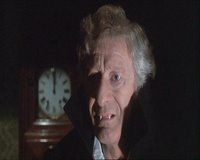 That night, being something of a student of the supernatural, he tries to research the cloak. Interestingly again, one of the books he uses is Montague Summers “The Vampire: His Kith and Kin”. He puts the cloak on as the clock strikes midnight and develops fangs and then finds himself floating. This scene is played very much for laughs.
That night, being something of a student of the supernatural, he tries to research the cloak. Interestingly again, one of the books he uses is Montague Summers “The Vampire: His Kith and Kin”. He puts the cloak on as the clock strikes midnight and develops fangs and then finds himself floating. This scene is played very much for laughs.
The next day there are no scenes with the cloak and, to apologise to Carla, he takes her out for a meal. 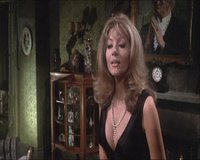 Back at the house he notices a newspaper report that says that the costumer shop has burnt down and a man’s body was found in a coffin in the basement. He realises that the body was Von Hartmann and tells Carla that he believes that the cloak was actually a vampire cloak, carrying the spirit of the vampire. She goads him into putting the cloak on, to disprove his theory and he does so, again at the stroke of midnight. Nothing happens. Then he realises that it is not his cloak but a prop from the movie.
Back at the house he notices a newspaper report that says that the costumer shop has burnt down and a man’s body was found in a coffin in the basement. He realises that the body was Von Hartmann and tells Carla that he believes that the cloak was actually a vampire cloak, carrying the spirit of the vampire. She goads him into putting the cloak on, to disprove his theory and he does so, again at the stroke of midnight. Nothing happens. Then he realises that it is not his cloak but a prop from the movie. 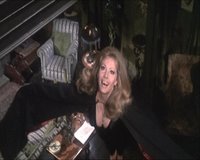 Carla reveals that she has his cloak. She also says, as she dons it, that they have enjoyed his portrayal of a vampire and want him to be like them for ever – indicating that Carla was a vampire, that she left the card and revealing one thing about vampires in the movie, sunlight is not a factor as we have seen Carla in the daytime. It also begs the question, why does she needs the cloak? She flies at him, fanged, and he screams.
Carla reveals that she has his cloak. She also says, as she dons it, that they have enjoyed his portrayal of a vampire and want him to be like them for ever – indicating that Carla was a vampire, that she left the card and revealing one thing about vampires in the movie, sunlight is not a factor as we have seen Carla in the daytime. It also begs the question, why does she needs the cloak? She flies at him, fanged, and he screams.
Thus ends the segment but the story is not over. Holloway takes the keys to the house from Stoker and goes there, despite Stoker’s warning to wait until daylight. He reaches the house and goes into the cellar, breaking into a padlocked room (question unanswered is who padlocked it). 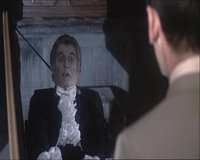 A coffin opens and a very grey faced Henderson sits and launches at Holloway, who stumbles backwards, breaks a chair and stakes the actor. A second coffin opens and Carla emerges. We see Holloway attacked by a bat – though we only see the shadow of the bat.
A coffin opens and a very grey faced Henderson sits and launches at Holloway, who stumbles backwards, breaks a chair and stakes the actor. A second coffin opens and Carla emerges. We see Holloway attacked by a bat – though we only see the shadow of the bat.
The film then codas with Stoker telling us that the house reflects the personality of the occupier and it awaits a decent tenant.
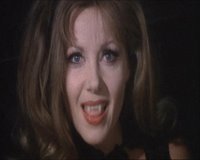 One of the shames of the vampire segment is that, because it is played as a comedy (we even have a lingering close up of a donate blood poster in the studio) it really does not fit in with the rest of the film. That said, Pertwee is magnificently arrogant as Henderson and Pitt is magnificently beautiful. It was not accidental, I am sure, that all her dresses had plunging necklines and the director ensured there were plenty of cleavage shots.
One of the shames of the vampire segment is that, because it is played as a comedy (we even have a lingering close up of a donate blood poster in the studio) it really does not fit in with the rest of the film. That said, Pertwee is magnificently arrogant as Henderson and Pitt is magnificently beautiful. It was not accidental, I am sure, that all her dresses had plunging necklines and the director ensured there were plenty of cleavage shots.
The story also feels a little forced, especially after Lee’s “Sweets to the Sweet” section. There are logical errors aplenty, including such as why Carla must sleep in a coffin when she presumably didn't before she turned Henderson? That said, the good thing about the segment is the references it contains and the fact that it is self-effacing. All in all I think the vampire segment deserves 5 out of 10.
The imdb page is here.
A review of the 2020 Region B Blu-Ray release is here.
Posted by
Taliesin_ttlg
at
3:29 AM
3
comments
![]()
Labels: undead, vampire, vampiric possession
Saturday, September 23, 2006
Immortally yours
 “a romance that will chill you”
“a romance that will chill you”
Or so the tagline says. I mentioned this a little while ago. The Homepage now has a lot more detail on it now. Nip over for more info.
Posted by
Taliesin_ttlg
at
3:14 AM
0
comments
![]()
Thursday, September 21, 2006
Vampire in Brooklyn - review
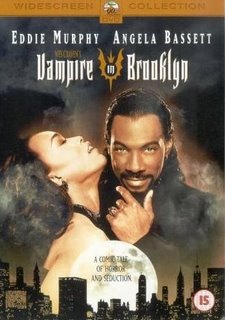 Directed by: Wes Craven
Directed by: Wes Craven
Release Date: 1995
Contains Spoilers
I have heard, though I cannot vouch for the validity of this, that Vampire in Brooklyn suffered because Wes Craven wanted to shoot a comedy and Eddie Murphy wanted to shoot a straight horror. It is certainly clear, as you watch this, that the horror and comedy are kept at arms length from each other for the most part.
Eddie Murphy plays Maximilian. Vampires, in this, came from Egypt. They scattered, some to the Carpathians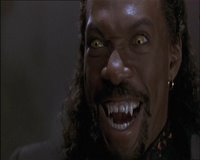 and others to a hidden island in the area we now call the Bermuda Triangle. Hunters eventually came to their island bolt hole and Max is the last vampire. He needs a companion to survive and has come to Brooklyn seeking out a mate. She is a half vampire, the product of the mating between a vampire male and human woman and, though he doesn’t know who she is, he will know her on sight.
and others to a hidden island in the area we now call the Bermuda Triangle. Hunters eventually came to their island bolt hole and Max is the last vampire. He needs a companion to survive and has come to Brooklyn seeking out a mate. She is a half vampire, the product of the mating between a vampire male and human woman and, though he doesn’t know who she is, he will know her on sight.
She is Rita (Angela Bassett), a cop whose mother recently died in a mental asylum and Max is on a mission to seduce her before the next full moon. Unfortunately he has to break the attraction between her and her partner Justice (Allen Payne).
The story, thus, is a combination of standard vampire plot (vampire searches for love) with a huge touch of Dracula thrown in. 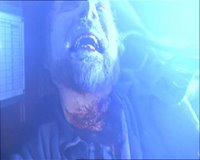 So, in line with Dracula and the landing of the vampire onboard the Demeter, Maximilian comes to Brooklyn onboard a ship, replete with drained sailors, that comes crashing through the harbour and goes to land in the form of a giant wolf. Despite having clichéd elements, however, the film has a definite slickness to it.
So, in line with Dracula and the landing of the vampire onboard the Demeter, Maximilian comes to Brooklyn onboard a ship, replete with drained sailors, that comes crashing through the harbour and goes to land in the form of a giant wolf. Despite having clichéd elements, however, the film has a definite slickness to it.
The vampires are fairly powerful in this. They must avoid the sun, can be staked, dislike holy items (Max starts to smoke when he enters a church and, in an understated element, Rita’s cross leaves a burn on her chest when she is being seduced by Max).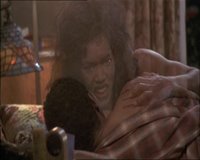 They move incredibly fast, can create mist, blow up dogs and cast spells which can convert a dirty Brooklyn flat to something that appears palatial. They have no reflection and Rita’s fading reflection , as she falls under Max's sway, is well handled. A bitten human will not turn if the vampire does not chose to turn them (the vampires are a race not a club, we hear) but one being turned must feed to fully turn and the death of the full vampire can save them before this happens.
They move incredibly fast, can create mist, blow up dogs and cast spells which can convert a dirty Brooklyn flat to something that appears palatial. They have no reflection and Rita’s fading reflection , as she falls under Max's sway, is well handled. A bitten human will not turn if the vampire does not chose to turn them (the vampires are a race not a club, we hear) but one being turned must feed to fully turn and the death of the full vampire can save them before this happens.
They can also create ghouls by placing a few drops of blood on a mortal’s tongue. 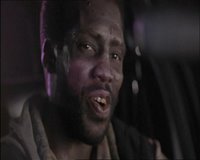 The ghoul Max creates is named Julius (Kadeem Hardison). The majority of the humour comes from this character, who is rotting where he walks and shedding body parts, as well as developing a taste for bugs. Max assures Julius that the benefits outweigh the downside and that he might well become a vampire in his own right, eventually. One of the best lines from Julius is when, before becoming a ghoul, he accuses Max of trying to pull that Blacula sh*t on him – a reference to the famous blaxploitation movie.
The ghoul Max creates is named Julius (Kadeem Hardison). The majority of the humour comes from this character, who is rotting where he walks and shedding body parts, as well as developing a taste for bugs. Max assures Julius that the benefits outweigh the downside and that he might well become a vampire in his own right, eventually. One of the best lines from Julius is when, before becoming a ghoul, he accuses Max of trying to pull that Blacula sh*t on him – a reference to the famous blaxploitation movie.
The rest of the comedy comes, in the main, from Murphy taking on other roles. At one point he feeds on, and then takes the form of, a failed stick-up man. The other was when he becomes a preacher who tries to convince his congregation (in an outdoor service as he cannot enter the church) that evil is good.
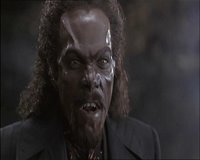 The failure of the film comes in a few forms. Firstly the film doesn’t really know if it is a comedy or horror and never truly becomes a comedy/horror. Next comes in the special effects. Whilst they are, in the main, really quite good, towards the end the vampire make up becomes heavier and heavier, and more and more demonic. This seemed unnecessary.
The failure of the film comes in a few forms. Firstly the film doesn’t really know if it is a comedy or horror and never truly becomes a comedy/horror. Next comes in the special effects. Whilst they are, in the main, really quite good, towards the end the vampire make up becomes heavier and heavier, and more and more demonic. This seemed unnecessary.
The main gripe I have, with regards this movie, is the lack of chemistry between the three main players in the love triangle of Max, Rita and Justice. It seemed unlikely that Justice would go out of his way for Rita or that Rita would care about Justice – though there was some chemistry between her and Max.
Murphy, however, looks good as a vampire and carries an air that fits the character well. Indeed it is Murphy who makes the film, playing Max in a restrained way and saving his more zany shinanigans for the other characters he plays. There are also some very classy scenes. 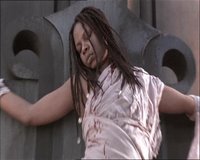 The one in particular that springs to mind is when Max beds Rita’s flatmate, Nikki (Simbi Khali). Rita believes her to be in bed with Justice and, having had a nightmare, relieves her frustration by painting. We fast cut between frantic brush strokes and distressed scenes of Nikki as Max attacks her. The fast cuts end as we see blood seep from the keyhole to her room. Nikki is later found crucified in a way that matches Rita’s painting.
The one in particular that springs to mind is when Max beds Rita’s flatmate, Nikki (Simbi Khali). Rita believes her to be in bed with Justice and, having had a nightmare, relieves her frustration by painting. We fast cut between frantic brush strokes and distressed scenes of Nikki as Max attacks her. The fast cuts end as we see blood seep from the keyhole to her room. Nikki is later found crucified in a way that matches Rita’s painting.
There is a definite panache to the film that could have made this a classic if the film had managed to plough a true furrow between horror and comedy, if the script had not been as clichéd in its vampire plot as it was, and the cast had engaged the emotional responses of the audience. As it stands, it is above average. 6 out of 10.
The imdb page is here.
Posted by
Taliesin_ttlg
at
9:17 AM
0
comments
![]()
Labels: vampire
Wednesday, September 20, 2006
Blood: the last vampire - news
 Cinematical have recently run a little piece on the live action version of this. Interesting snippets include:
Cinematical have recently run a little piece on the live action version of this. Interesting snippets include:
- Shooting could start as early as late October/early November.
- Ronny Yu wants to "reinvent" the vampire genre. To do this he plans to move away from "greys and blues" to a full "multimedia" color approach.
- The setting will be moved from 1960 to 1948 Tokyo.
Posted by
Taliesin_ttlg
at
8:21 AM
0
comments
![]()
Tuesday, September 19, 2006
Requiem for a Vampire {2006} – review
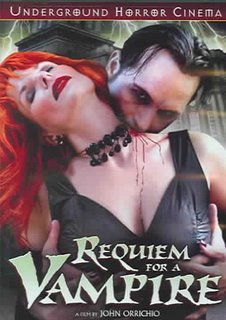 Directed by: John Orrichio
Directed by: John Orrichio
Release Date: 2006
Contains spoilers
So I noticed that there was a film that shared its name with Jean Rollin’s opus and then I read the synopsis and I think to myself, I have to see that…
The basic story of Requiem for a Vampire is that a clan of vampires, living in New Jersey, use a blood bank in order to fulfil their needs. The patriarch of the family – Michael (Matt Locker) - is rich, owns a compound, a nightclub, sings in a rock band and has political ambitions. His wife Adelaide (Mona Sethi) goes out for a walk and a man attempts to rape her. She grievously injures him and then feeds. Suddenly she is ill, his blood is tainted.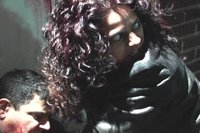
Though they do not say so directly, it is clear that he was HIV+. The virus proves extremely virulent within a vampire’s physiology and she quickly dies. The family is distraught, they want to have a ceremony but a vampire has never died before (that they are aware of) and so they turn to anthropologist Tara Wolf (Jamie Stone) and her parapsychologist friend Rosemary Guiley (played by herself). The first of the problems raises it’s head here, Rosemary Guiley is actually a paranormal investigator (I have discovered, as I hadn’t heard of her before, though I admit I realised, as I checked for this review, that her books have been spotted – though not purchased - by myself). The blatant product placement of her book “Vampires Among Us” was bad enough but, whilst I guess she was in the film to offer an authenticity to the proceedings, actor she is most certainly not.
Tara has found an old reel to reel tape of an “ancient one’s” funeral being described – 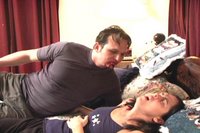 logic hole, as vampires came from all over the world to the funeral, how come not one of them could have offered the details of the ritual – and will help the family on one condition, that she is turned. Rosemary’s role, well it is tagged on it appears – she gets to write an eulogy! Incidentally, the anthropologist, who recorded the ritual in England in the 30s, mentions that to be told where the ritual was he paid gold coins. No. He’d have paid in pounds, shillings and pence – as hard as it is to believe 1930s England was not Middle Earth.
logic hole, as vampires came from all over the world to the funeral, how come not one of them could have offered the details of the ritual – and will help the family on one condition, that she is turned. Rosemary’s role, well it is tagged on it appears – she gets to write an eulogy! Incidentally, the anthropologist, who recorded the ritual in England in the 30s, mentions that to be told where the ritual was he paid gold coins. No. He’d have paid in pounds, shillings and pence – as hard as it is to believe 1930s England was not Middle Earth.
This basic premise could have been good but there was so much superfluous story. There is the sub-plot of Jerry (Bob Smith), from the health department, who is suspicious of the blood bank. He photographs the entire Adelaide attempted rape and feed and then… well he tries to sell the pictures to a local paper and then extort money from the family. This plot goes nowhere until he witnesses the ritual and communicates it to the reporter until he is stabbed by a human servant. The plot is then quickly tied up, at the end of the movie, in a letter that mentions that no one missed Jerry and the reporter and her editor had a terrible accident.
Having mentioned the feed, the finding of the body by the cops was, again, superfluous as it wasn’t mentioned again. Perhaps if the family had bought them off it would have been worth shooting the scene, but in truth it was unnecessary.
There is a sexual sub plot with household help Henri (David B Powers) who has been promised immortality. Michael has a homosexual sex scene with him that seemed pointless other than to make Henri suicidal as he wasn’t turned. I want to add that I am not against the scene for any homophobic reason, just because it adds nothing to the film in a plot sense.  However it does, in turn, lead Michael’s sister, Lenore (Deana Enoches), to turn Henri. This, apparently, annoys Michael but we hear nothing else until the ‘letter scene’ at the end of the film where it mentions that Michael is still annoyed. The only other purpose of Lenore seems to be to do a bit of voice over, to hint at an incestuous relationship with Michael and to let upset men suckle at her breast for comfort.
However it does, in turn, lead Michael’s sister, Lenore (Deana Enoches), to turn Henri. This, apparently, annoys Michael but we hear nothing else until the ‘letter scene’ at the end of the film where it mentions that Michael is still annoyed. The only other purpose of Lenore seems to be to do a bit of voice over, to hint at an incestuous relationship with Michael and to let upset men suckle at her breast for comfort.
There is a sub-plot about Michael’s band that does nothing and one about his political ambitions that we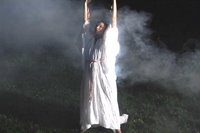 don’t actually hear anything about until the final scene. In fact let me mention, for a second, the God awful musical interludes that add nothing to the film. When Adelaide dies, the bagpipes and guitar with white clad dancers and Henri’s niece Clair (Cathy Loch) singing was so out of place. I guess someone had watched “The Two Towers” once too often and tried to replicate the mood of the funeral scene (specifically the woman singing aspect)… and failed.
don’t actually hear anything about until the final scene. In fact let me mention, for a second, the God awful musical interludes that add nothing to the film. When Adelaide dies, the bagpipes and guitar with white clad dancers and Henri’s niece Clair (Cathy Loch) singing was so out of place. I guess someone had watched “The Two Towers” once too often and tried to replicate the mood of the funeral scene (specifically the woman singing aspect)… and failed.
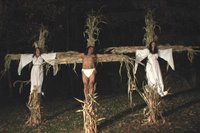 All this distracts from an original idea - suddenly vulnerable vampires having to develop a funeral ritual for one of their own. This funeral could have been brilliant, if shot by the right director (let us say Rollin as the film shares its name with one of his). The funeral starts with a casket being carried to a field. A mock crucifixion is awaiting it. The Christ figure gets down and is led away and then the two crucified girls get down, disrobe and dance naked around the casket. Once they leave the body is removed, held aloft to the sky and then placed on a bier (on the tape it said in a pit) and burned. As I say in the right hands it could have been a genius piece of surrealistic filmwork.
All this distracts from an original idea - suddenly vulnerable vampires having to develop a funeral ritual for one of their own. This funeral could have been brilliant, if shot by the right director (let us say Rollin as the film shares its name with one of his). The funeral starts with a casket being carried to a field. A mock crucifixion is awaiting it. The Christ figure gets down and is led away and then the two crucified girls get down, disrobe and dance naked around the casket. Once they leave the body is removed, held aloft to the sky and then placed on a bier (on the tape it said in a pit) and burned. As I say in the right hands it could have been a genius piece of surrealistic filmwork.
The vampires drink blood. There is no mention of the sun, but we only see them at night. Sleeping in coffins is not necessary, holy symbols and other such things are not effective (Michael’s best friend is a priest and sits by Amelia’s death-bed).  Through Tara we discover that they are strong, can read fast and learn at an astounding pace but have a terribly quick anger (though presumably it is the young ones that suffer most from that).
Through Tara we discover that they are strong, can read fast and learn at an astounding pace but have a terribly quick anger (though presumably it is the young ones that suffer most from that).
The acting is generally bad, which doesn’t help, I just couldn’t suspend disbelief, worst still because the dialogue was so corn-ball in places.
I had high expectations from this film, probably a silly thing to have, and the central premise was unique and interesting – though why someone who is dead need worry about HIV/AIDS is a question best left ignored. It needed honing, superfluous plotting cleaned up and a more proficient cast in order to live up to that great central idea
I really hate giving this movie such a low score, it had an intelligent premise that is so lacking in many of the straight to DVD films that are flooding the market, but can do nothing more than give it 2 out of 10. A great opportunity lost.
The imdb page is here.
Posted by
Taliesin_ttlg
at
7:33 AM
0
comments
![]()
Labels: vampire
Monday, September 18, 2006
Manitou Blood – review
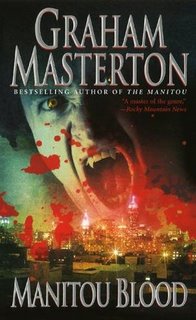 Author: Graham Masterton
Author: Graham Masterton
Release Date: 2005
Contains spoilers
Flush with my enjoyment of Descendant, I noticed this in a local bookstore. Couple of things to note, firstly whilst Manitou Blood is about strigoï, it is not the same type of vampire as we met in Descendant and the rules are somewhat different. Second thing to note is that this is (the latest) part of a series, with recurring characters from said series. That said it is designed to stand alone and, given that I have not read the others in the series, does that admirably.
The book begins with Doctor Frank Winter watching a street mime, a young woman, covered in silver body paint, with whom he is fascinated. At the end of her performance Frank approaches her but she begins to copiously vomit blood and he rushes her to his hospital. The tests are bizarre, she is hyper-sensitive to sunlight (only the body paint allowed her to go into the light it seems), she is anaemic and there is a strange element in her blood. Scans show no ulcer that could have caused the blood vomiting and when the test results come back they discover that it is two different blood-types, neither hers. We then discover that she felt as though she had been burning up, back in her apartment, and slit the throats of her flatmates as drinking their blood was the only thing that, she believed, could cool her.
Soon more and more cases are coming to light, each time the same and the doctors search for a new virus whilst the press talk about vampire killings. All the victims started with symptoms including hydrophobia and recurring dreams – all the same – of being locked in coffins whilst crossing the ocean. All the victims seem to chant the same strange phrase, “Tatal Nostru.”
Harry Erskine, one of the recurring characters, is a psychic conman who has been forced to accept the supernatural. He is approached by a young man who is having recurring dreams. Trying to contact his spirit guide, Singing Rock, Harry is shown the source of the young man’s nightmares a malevolent spirit that he only catches a fleeting glimpse of. It soon becomes clear, as he discovers about the disease, that it is no natural disease but a spiritual attack on the city. However, by then the vampires have reached plague proportions and all the infected soon die… at which point their bodies get up and continue to function. New York City is in chaos and the authorities have abandoned it, forming a perimeter quarantine. It is up to the odd-ball group of Harry, Gil (an ex-soldier), Frank (now infected himself) and Jenica (the daughter of a Romanian strigoï expert) to stop the infection before it spreads city to city.
The vampires are strigoï, but different to those in Descendant. The infected are controlled by a powerful dead vampire or svarcolaci. To stop the spread of the plague they have to find and bind that entity and, of course, find a way to stop those already turned. The book mixes things up well. The prose is a combination of third person and (when with Harry) first person, that works well. The myth sources mix Romanian vampire lore with Native American spirituality.
The recurring characters work well, despite having not met them before. Harry is fantastic, a real anti-hero rogue out to make a fast buck and then faced with the undeniable task of being honourable and saving the world.
In Descendant we had vicious vampires and these are similar, yet I don’t think their impact was as strong. The book has its fair share of gore and the infection is virulent and overruns a city, giving an apocalyptic feel that shared much with I Am Legend and yet there was a sadness to it. We see the infected with sympathy due to the focus on the anguish of one or two of them, and that lessens, to a degree, their impact. They are less the faceless beasts of the night – especially due to Frank who fights the infection – but poor, scared people forced to act in horrific ways by factors out wih their control. Don’t get me wrong, this is still more horror than many titles out there, just not as intense as Descendant.
If I had another issue with the novel, then that issue is within me rather than the book itself and it is the apocalyptic nature of the novel. I enjoyed Descendant more than this because it seemed more microcosmic. Manitou Blood shows the rapid destruction of a city on a macrocosmic scale. Perhaps if we had seen more of the plight of the ordinary citizens, holed up fearful as the vampires ruled the night... but the main human characters were extraordinary and whilst I appreciated them as characters I perhaps didn’t resonate with them completely. However, this is not a fault of the book, as I say, and it does not spoil the novel. It is, however, not exactly what I was searching for.
It is difficult to explain the lore Masterton uses in this without giving too much plot away but I will mention mirrors. We often see the image of smashed mirrors in vampire films, vampires smashing them for they have no reflection. In this the dead strigoï are able to pass through mirrors, using them as doorways. It is the humans who smash them.
This is a rip-roaring adventure horror with very much an occult/spiritualistic slant, not quite as good as the later book but still well worth your time and effort. 7.5 out of 10.
Posted by
Taliesin_ttlg
at
7:36 AM
0
comments
![]()
Labels: plague, strigoï, svarcolaci, vampire
Sunday, September 17, 2006
Polanski Honoured
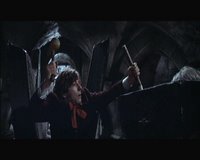 According to Contactmusic.com the European Film Academy is to honour Roman Polanski with a life time achievement award - to be given to him on the 2nd December, this year.
According to Contactmusic.com the European Film Academy is to honour Roman Polanski with a life time achievement award - to be given to him on the 2nd December, this year.
Polanski was responsible for the film The Fearless Vampire Killers (1967), both directing and starring in the film. To mark the occasion I hope to do a review of the movie to post (all things being fair) on the day Polanski receives his award.
Posted by
Taliesin_ttlg
at
9:03 AM
0
comments
![]()
Saturday, September 16, 2006
The Hunger “Nunc Dimittis” – Review (TV Episode)
 Directed By: Russell Mulcahy
Directed By: Russell Mulcahy
Season 2, released 1999
Contains spoilers
The Hunger was a supernatural TV series of short films produced by Tony and Ridley Scott. Despite the involvement of Tony Scott and the name of the series this was not related to the 1983 movie, though the series 1 DVD insert claims it was inspired by said film. Unlike season 1, though there was often a sexual aspect, there wasn’t the same explicitness in all the episodes. Season 2 was introduced, episode by episode, by David Bowie portraying the spirit of the character he played in the season opener. The series itself is very good generally; however the quality can vary, from the pure horror (generally good) through to something like the Red Shoe Diaries with a murder/supernatural twist (poor).
Nunc Dimittis was based upon a short story by Tanith Lee and, I guess, could have been named the Renfield’s Tale. The title actually comes from the Latin of a canticle, the English version, from the Divine Office, of the beginning being:
At last, all-powerful Master,
You give leave to your servant
to go in peace, according to your promise
Which sums the story up beautifully. 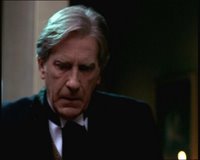 We begin with Vassu (David Warner), the servant in question. There is some nice thumbing of the nose at traditional vampire story imagery. There are cloves of garlic hanging in the kitchen and Vassu catches a moth but, rather than eat it, he releases it into the city night. He takes a tray to his mistress the Princess Daragan Draculus (Marina Orsini). When with her he informs her that he is dying, with perhaps a few more days left. The look the filmmakers gave her is interesting, she is old and her ears are pointed. Continuing with the thumbing of traditional vampire stories, she wears a cross.
We begin with Vassu (David Warner), the servant in question. There is some nice thumbing of the nose at traditional vampire story imagery. There are cloves of garlic hanging in the kitchen and Vassu catches a moth but, rather than eat it, he releases it into the city night. He takes a tray to his mistress the Princess Daragan Draculus (Marina Orsini). When with her he informs her that he is dying, with perhaps a few more days left. The look the filmmakers gave her is interesting, she is old and her ears are pointed. Continuing with the thumbing of traditional vampire stories, she wears a cross.
Interspersed we see scenes of Snake (Jacob Tierney), a male prostitute, drug addict, thief and homeless kid.
The Princess reminisces with Vassu about her youth, about her hunger and her lusts – though now she sleeps seldom and eats little. Vassu informs her that he wishes to perform one last service, that of finding her a new servant, and leaves to search the city for a suitable replacement. Snake is following him when he stops, standing in the street whilst he remembers. He remembers being chased by angry townsfolk, whilst bleeding, and stumbling across the Princess in the woods, she seems to blaze. Snake tries to mug Vassu in an alleyway but the old man easily disarms him and tosses him across the alley. Then he returns the young man’s gun and offers him a warm meal. Snake, believing him to be a trick, follows.
True to his word, Vassu feeds the young man and ignores his fairly obvious petty larceny. He tells Snake that he has been brought for the Princess and it is clear that Snake half recognises her name. This is in reference to Dracula, of course, and Vassu informs Snake that she is of another branch of the family, he also makes reference to being ten times Snake’s age. Snake obviously does not believe in vampires, but couldn’t really care less what these rich marks call themselves. Then he is introduced to the Princess, who has the neat trick of being able to light candles with a gesture.
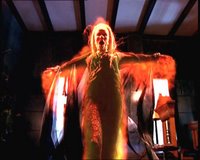 He is fascinated by her cross (we learn later that Vassu was as well) but it is denied to him. He tries to act sexually towards her, whore to client, and she reacts angrily, becoming a blazing beacon of light. Snake runs from the house. When asked, Vassu says he chose him because he is like Vassu was when she found him, Snake has the same anger. Vassu noticed a long lost fire in his Mistress’ eyes when Snake was there. It is clear that the Princess approves of the choice.
He is fascinated by her cross (we learn later that Vassu was as well) but it is denied to him. He tries to act sexually towards her, whore to client, and she reacts angrily, becoming a blazing beacon of light. Snake runs from the house. When asked, Vassu says he chose him because he is like Vassu was when she found him, Snake has the same anger. Vassu noticed a long lost fire in his Mistress’ eyes when Snake was there. It is clear that the Princess approves of the choice.
Snake dreams of the forests. He awakens in Hell, or that is what his ‘home’ – an abandoned pool filled with misfits and junkies – suddenly appears to be, a noisy bedlam that summoned up a feeling of Boch or Dante. Two toughs find him and he is stabbed, back at the house Vassu feels the stabbing. Snake struggles back to the house and is taken to the Princess. 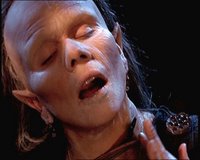 She tells him that, as Vassu informed him, she is from a different branch of the family to the infamous Count and the family branches have different ways. She then slits her own throat and has the young man feed. The blood heals his wounds and the Princess becomes young again. They love (though the scene is very understated compared to such scenes in season 1, a hint and no more) as Vassu falls in the kitchen, finally at rest.
She tells him that, as Vassu informed him, she is from a different branch of the family to the infamous Count and the family branches have different ways. She then slits her own throat and has the young man feed. The blood heals his wounds and the Princess becomes young again. They love (though the scene is very understated compared to such scenes in season 1, a hint and no more) as Vassu falls in the kitchen, finally at rest.
As the film ends Snake is now the servant and the Princess has maintained her newly regained youth.
This is a fascinating tale. Not only does it, very gently, ignore standard vampire myth factors (the cross, the garlic and the servant not eating bugs) but it offers a fairly unique perspective – that of the human servant. Of course we often see the human servant and, in many films, we have show stopping performances – the prime example being Dwight Frye’s performance in Dracula (1931) - but too often (as in the mentioned film) the servant is mad and, whilst they may take an active part, the story never focuses primarily on them. In this case we focus on the servant, the servant seems sane and, even more interestingly, the servant is redeemed by the vampire.
Both Vassu and Snake are criminals, both are very close to losing their lives because of their lifestyles and it is through the vampire they are given a purpose, elongated lives and a genteel air rather than the air of the thug.
This is underpinned by the scenes in the house which, despite the Princess’ angry display of powers, seems refined and civilised and the scenes in the outside world, which are brutal and chaotic. 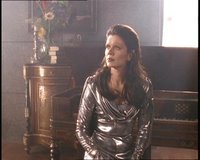 It is also suggested that the tie between vampire and servant is intimate, not just in a sexual sense but in a sense of condition. When Vassu, who has reached the end of his extended life, is the servant, we see a vampire who is ancient, a vampire that may be coming to the end of her life. When Vassu gives her a young replacement she too becomes young.
It is also suggested that the tie between vampire and servant is intimate, not just in a sexual sense but in a sense of condition. When Vassu, who has reached the end of his extended life, is the servant, we see a vampire who is ancient, a vampire that may be coming to the end of her life. When Vassu gives her a young replacement she too becomes young.
The acting is good. The interaction between Vassu and the Princess is believable and both come across as refined, the proper lady and servant. The role of Snake is convincingly played by Tierney; we can believe him to be the thug faced with things beyond his understanding.
This is a great short film and a worthy episode of the series, though one would expect that given that the story came, originally, from a source as creative as Tanith Lee. The only real problem is that we are given a fascinating glimpse of incredibly interesting characters and perhaps an episode of more substantial length would have given us even more. 7 out of 10 for a stylishly filmed, fascinating look at the genre.
The imdb page is here.
Posted by
Taliesin_ttlg
at
3:58 AM
0
comments
![]()
Labels: vampire














